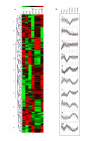A microarray-based method for the parallel analysis of genotypes and expression profiles of wood-forming tissues in Eucalyptus grandis
- PMID: 19473481
- PMCID: PMC2698882
- DOI: 10.1186/1472-6750-9-51
A microarray-based method for the parallel analysis of genotypes and expression profiles of wood-forming tissues in Eucalyptus grandis
Abstract
Background: Fast-growing Eucalyptus grandis trees are one of the most efficient producers of wood in South Africa. The most serious problem affecting the quality and yield of solid wood products is the occurrence of end splitting in logs. Selection of E. grandis planting stock that exhibit preferred wood qualities is thus a priority of the South African forestry industry. We used microarray-based DNA-amplified fragment length polymorphism (AFLP) analysis in combination with expression profiling to develop fingerprints and profile gene expression of wood-forming tissue of seven different E. grandis trees.
Results: A 1578-probe cDNA microarray was constructed by arraying 768 cDNA-AFLP clones and 810 cDNA library clones from seven individual E. grandis trees onto silanised slides. The results revealed that 32% of the spotted fragments showed distinct expression patterns (with a fold change of at least 1.4 or -1.4 and a p value of 0.01) could be grouped into clusters representing co-expressed genes. Evaluation of the binary distribution of cDNA-AFLP fragments on the array showed that the individual genotypes could be discriminated.
Conclusion: A simple, yet general method was developed for genotyping and expression profiling of wood-forming tissue of E. grandis trees differing in their splitting characteristics and in their lignin contents. Evaluation of gene expression profiles and the binary distribution of cDNA-AFLP fragments on the chip suggest that the prototype chip developed could be useful for transcript profiling and for the identification of Eucalyptus trees with preferred wood quality traits in commercial breeding programmes.
Figures

Similar articles
-
Within-tree transcriptome profiling in wood-forming tissues of a fast-growing Eucalyptus tree.Tree Physiol. 2006 Mar;26(3):365-75. doi: 10.1093/treephys/26.3.365. Tree Physiol. 2006. PMID: 16356907
-
Development and assessment of microarray-based DNA fingerprinting in Eucalyptus grandis.Theor Appl Genet. 2004 Nov;109(7):1329-36. doi: 10.1007/s00122-004-1759-9. Epub 2004 Jul 29. Theor Appl Genet. 2004. PMID: 15290050
-
Genome-wide mapping of histone H3 lysine 4 trimethylation in Eucalyptus grandis developing xylem.BMC Plant Biol. 2015 May 10;15:117. doi: 10.1186/s12870-015-0499-0. BMC Plant Biol. 2015. PMID: 25957781 Free PMC article.
-
Eucalyptus hairy roots, a fast, efficient and versatile tool to explore function and expression of genes involved in wood formation.Plant Biotechnol J. 2016 Jun;14(6):1381-93. doi: 10.1111/pbi.12502. Epub 2015 Nov 18. Plant Biotechnol J. 2016. PMID: 26579999 Free PMC article.
-
A high-density transcript linkage map with 1,845 expressed genes positioned by microarray-based Single Feature Polymorphisms (SFP) in Eucalyptus.BMC Genomics. 2011 Apr 14;12:189. doi: 10.1186/1471-2164-12-189. BMC Genomics. 2011. PMID: 21492453 Free PMC article.
Cited by
-
Xylem transcription profiles indicate potential metabolic responses for economically relevant characteristics of Eucalyptus species.BMC Genomics. 2013 Mar 22;14:201. doi: 10.1186/1471-2164-14-201. BMC Genomics. 2013. PMID: 23521840 Free PMC article.
-
Large-Scale Transcriptome Analysis of Two Sugarcane Genotypes Contrasting for Lignin Content.PLoS One. 2015 Aug 4;10(8):e0134909. doi: 10.1371/journal.pone.0134909. eCollection 2015. PLoS One. 2015. PMID: 26241317 Free PMC article.
-
Co-expression network of transcription factors reveal ethylene-responsive element-binding factor as key regulator of wood phenotype in Eucalyptus tereticornis.3 Biotech. 2018 Jul;8(7):315. doi: 10.1007/s13205-018-1344-6. Epub 2018 Jul 13. 3 Biotech. 2018. PMID: 30023147 Free PMC article.
-
Transcriptome sequencing and profiling of expressed genes in cambial zone and differentiating xylem of Japanese cedar (Cryptomeria japonica).BMC Genomics. 2014 Mar 20;15:219. doi: 10.1186/1471-2164-15-219. BMC Genomics. 2014. PMID: 24649833 Free PMC article.
-
Construction of co-expression network based on natural expression variation of xylogenesis-related transcripts in Eucalyptus tereticornis.Mol Biol Rep. 2016 Oct;43(10):1129-46. doi: 10.1007/s11033-016-4046-3. Epub 2016 Jul 27. Mol Biol Rep. 2016. PMID: 27465117
References
-
- Godsmark R. The South African Forestry and Forest Products Industry 2007. Forestry S A. 2008. http://www.forestry.co.za/website_industry_data
-
- Malan FS. The control and-splitting in saw logs: A short literature review. South African Forestry Journal. 1979;109:14–18.
-
- Barros E, Verryn S, Hettasch M. Identification of PCR-based markers linked to wood splitting in Eucalyptus grandis. Ann For Sci. 2002;59:675–678. doi: 10.1051/forest:2002055. - DOI
Publication types
MeSH terms
Substances
LinkOut - more resources
Full Text Sources

